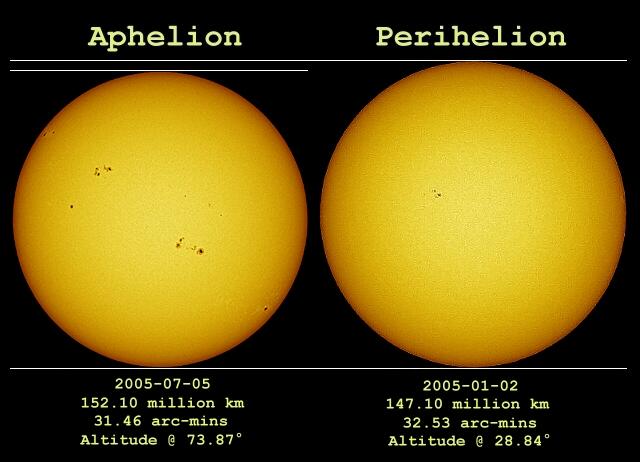On January 5, 2020, the Earth will be the closest it will ever get to the Sun in the 21st century, at a nice and cozy distance of 91,398,199 miles. The pair will be about a million and a half miles nearer to each other than they are on average, which is over six times the distance from the Earth to the Moon. Since it’s in vogue to call large full Moons “supermoons”, I would like to dub this event the “supersun”. Of course, there’s a lot to the hows and whys and what it means other than “it’s big and close”, so I wanted to spend some time talking about it.
Planets don’t orbit the Sun in perfect circles, because that would make things far too simple for everyone. Instead they trace a very slight elliptical path (or at least in our Solar System they do), but it’s subtle enough that we couldn’t figure that out until the 17th century. When these oblong orbits are combined with the axial tilt of the Earth, sunrises and sunsets can be up to 15 minutes earlier or later than we would expect. For our Earth, the closest approach, or perihelion, takes place in early January (for now), and its counterpart, the aphelion, is in early July.

What makes this year’s perihelion extra special can be attributed to the alignment of Jupiter and Saturn. Planets don’t technically orbit the Sun, but the center of mass of the Solar System as a whole. When the gas giants are both on the same side, this barycenter can be hundreds of thousands of miles away from the center of the Sun. It happens that this year, this phenomenon compounds with our annual elliptical orbit to push us really close to our star. This works the other way too: The summer of 2019 featured the greatest aphelion in the 21st century.
There are even more cycles that affect perihelion in the long term. Earth’s axis wobbles such that over a 26,000-year span, the start of the seasons shift. By the year 15000 AD, we would be closest to the Sun in early summer instead of winter. This shift is also why the astrological zodiac is misaligned by a month and why we’re supposedly entering the Age of Aquarius (though everything else space-related in that song is complete nonsense). Furthermore, the eccentricity, or how elliptical or circular our orbit is, of our planet is slowly going down as part of a 100,000-year back and forth cycle due to the minute gravitational pull of Jupiter and Saturn. All these changes and more do produce variations on our climate, though it takes place on a very slow scale.
So how much bigger will the supersun be? Well, it’s not quite the vast difference as one would get with a supermoon. In fact, the Sun’s diameter will be only about 2% bigger and 4% brighter than normal. The moon, on the other hand, varies its size by as much as 14%, producing a much more noticeable effect. Also, you can look at a full moon and enjoy its brightness; the same cannot be said for the sun, at least not without going blind.

One effect about the differing apparent size of the Sun is how it can change solar eclipses. When our star is further away during the spring and summer, there’s less of an area that the moon has to cover, and as such in the 21st century about two-thirds of total solar eclipses take place during that half of the year. Meanwhile the fall and winter months feature more annular eclipses where the Moon is not quite big enough to fully cover the Sun and instead creates a ring of light.
So if you wanted to be as close to the Sun as possible, where should you go? At the exact moment of perihelion, our star will be directly overhead of a spot in the Indian Ocean about 200 miles south of the tiny island of Rodrigues in Mauritius. You’d only be 91,394,240 miles away, a good 3961 miles closer than the average point on Earth. If you’re hoping to wait a bit to climb a mountain to get you even closer, you would be disappointed. The tallest peaks at that latitude are in the Andes, but in the nine hours it would take for the Sun to be above those peaks, our planet would already be a good 25 miles further away. At least this hypothetical expedition will take you to international waters, so you won’t have to worry about legal issues once there.

What if, due to some unexplained astronomical weirdness, the Earth were to get permanently stuck at this close radius? Would we feel it? Thankfully we have the Stefan-Boltzmann Law and a bit of math to tell us how hot a planet should be at a given distance from a star, barring the greenhouse effect and other such nuances. The key takeaway in our case is that temperature is proportional to one over the square root of the distance. Plugging in a few numbers, we’d see that the Earth would warm up by about 2 degrees Celsius. As a point of comparison, that’s about twice the amount the Earth has heated up due to manmade global warming, and around half of our current projections for 2100. It’d be survivable, but it’d be quite a mess for a long time while we’d have to get used to the new normal.
Leave a Reply